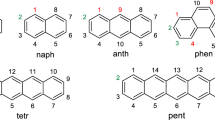Abstract
Pariser-Parr-Pople's semi empirical method is applied for the electronic study of chemical and physico-chemical properties of monoalkoxybenzenes; alkyl groups are differentiated through the variations of ionization potential of corresponding aliphatic alcohols. The evolution of calculated molecular quantities may be followed from benzene ones. In agreement with experimental data, this computation allow the reproduction of the first molecular ionization potential. The theoretical electronic spectra show essentially that, in the two first excited singlets, exists a non negligible charge transfer from the heteroatom. Finally, the study of electronic distribution show the influence of the alkyl group on the chemical reactivity.
Résumé
La méthode semi-empirique de Pariser-Parr-Pople est appliquée à l'étude électronique des propriétés chimiques et physico-chimiques des alcoxybenzènes, la différenciation des alkyls étant introduite par la variation du potentiel d'ionisation des alcools aliphatiques correspondants. D'une faÇon générale, il est possible de suivre l'évolution des diverses grandeurs calculées à partir des résultats obtenus pour le benzène. Le calcul permet de prévoir, en accord avec l'expérience, l'évolution du potentiel de première ionisation des molécules étudiées. Les spectres électroniques théoriques montrent essentiellement que les deux premiers singulets excités correspondent à des états de transfert de charge partiel vers le cycle aromatique. Enfin, l'étude des distributions électroniques sur les positions substituables montre l'influence de la nature de l'alkyl sur la réactivité des molécules envisagées.
Zusammenfassung
Die Methode von Pariser-Parr-Pople wird zur Untersuchung der chemischen und physikalischchemischen Eigenschaften der Monoalkoxybenzole herangezogen. Dabei werden die Alkylgruppen durch das Ionisationspotential der entsprechenden Alkohole charakterisiert und das Benzolmolekül als Standardsubstanz gewÄhlt. Dabei ergeben sich die ersten Ionisierungspotentiale entsprechend dem Experiment und die ersten zwei SingulettübergÄnge zeigen eine nicht mehr vernachlÄssigbare Ladungsübertragung vom Heteroatom. Zum Schlu\ wird der Einflu\ der Elektronenverteilung auf die chemische ReaktivitÄt diskutiert.
Similar content being viewed by others
Références
Pariser, R., and R. G. Parr: J. chem. Physics 21, 466, 767 (1963).
Pople, J. A.: Trans. Faraday Soc. 49, 1375 (1953).
“Interatomic Distances.” Supplement. London: Chemical Society Edts. 1965.
Paoloni, L.: Nuovo Cimento 4, 410 (1956).
Pariser, R.: J. chem. Physics 21, 568 (1953).
Hinze, J., and H. H. Jaffe: J. Amer. chem. Soc. 34, 540 (1962); -J. chem. Physics 67, 1501 (1963).
Kwiatkowski, S.: Acta Phys. Polon. 29, 477 (1966).
Parr, R. G.: J. chem. Physics 33, 1184 (1960).
Ohno, K.: Theoret. chim. Acta (Berl.) 2, 219 (1964).
Mataga, N., and K. Nishimoto: Z. physik. Chem. 13, 140 (1957).
Lykos, P. G.: J. chem. Physics 35, 1249 (1961).
Watanabe, K.: J. chem. Physics 26, 542 (1957).
Omura, I., K. Higasi, and H. Baba: Bull. chem. Soc. Japan 29, 504 (1956).
El Sayed, M. F., and M. Kasha: J. chem. Physics 34, 334 (1961).
Koopmans, T.: Physica 1, 104 (1933).
Hall, G. G., and J. Lennard-Jones: Proc. Roy. Soc. A 202, 155 (1950).
Kwiatkowski, S.: Acta Physica polon. 30, 529 (1966).
Julg, A.: J. Chim. physique 54, 493 (1957).
Kimura, K., and S. Nagakura: Molecular Physique 9, 117 (1965).
Dubois, J. E., P. Alcais et G. Barbier: Bull. Soc. Chim. France 605 (1968).
Nishimoto, K., and L. S. Forster: Theoret. chim. Acta (Berl.) 4, 155 (1966).
Author information
Authors and Affiliations
Rights and permissions
About this article
Cite this article
Leibovici, C. Etude théorique de derives substitués du benzène. Theoret. Chim. Acta 12, 34–47 (1968). https://doi.org/10.1007/BF00527005
Received:
Issue Date:
DOI: https://doi.org/10.1007/BF00527005




